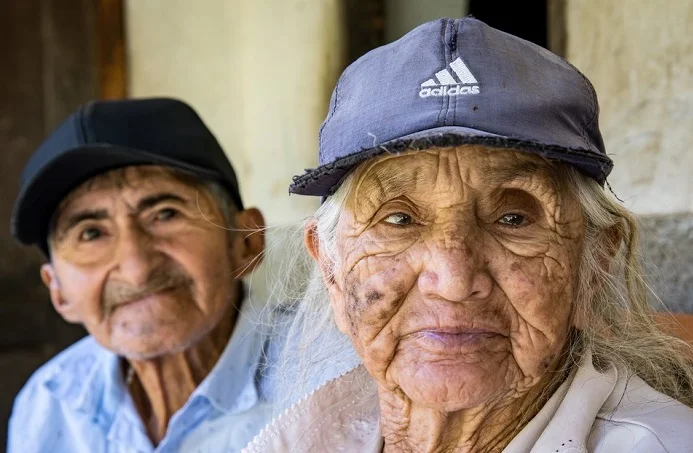The long-lived have a completely healthy heart and still carry out agricultural activities. What is the secret of Vilcabamba, the Ecuadorian valley where people live for over 100 years?
To the south of Ecuador, 40km from the city of Loja, is the Vilcabamba parish, also known as the “Valley of longevity”, as the “island of immunity for heart disease” or as “the country of the old oldest in the world”. These names are adhered to because a large number of its inhabitants have exceeded 100 years with their cognitive faculties intact and an exceptional state of health.
The name of this valley derives from the Quechua words Huilco and Bamba, which mean tree and valley. Hence, it is translated to “valley of the sacred tree”, which is related to the Huilco tree, to which curative properties are attributed.
Vilcabamba is a subtropical valley located 1,700 meters above sea level, it has a warm climate and without sudden changes in temperature, which usually stays between 18 and 22 degrees Celsius. These characteristics of the environment are believed to be favorable for the proper functioning of the heart.
This Ecuadorian territory rose to fame in the 1970s when National Geographic magazine published an article naming Vilcabamba as one of the “three islands of longevity” in the world. The list also included Abkhazia and the Hunza Valley in the Gilgit-Baltistan of Pakistan.
This new title caught the attention of scientists, doctors, and naturalists, who came to Vilcabamba to research all kinds with the aim of discovering the secret of the longevity of its elders. According to a 1994 report in The Baltimore Sun, an American newspaper, even tobacco companies were interested in the inhabitants of this valley, who had smoked “chamico” for many years without developing any type of cancer.
The chamico has been called “the cigar of the long-lived”, this is a traditional and natural cigar. Even now, the adults of Vilcabamba are in charge of sowing, harvesting, and making the “chamico”.
According to the Government of Loja, investigations have been carried out related to the diet of its inhabitants, the conditions of their bones, heart, and respiratory capacities. These have shown that the long-lived retain their patent arteries, their heart completely healthy and that their retinas are not very different from those of a 45-year-old.
The reasons for this exceptional state of health are presumed to be related to: climate, altitude, lifestyle, and water quality.
In Vilcabamba, it is not uncommon to find a centenarian adult doing agricultural work like any middle-aged farmer. This activity, plus the inhabitants’ morning walks, contributes to maintaining their physique.
Their lifestyle is complemented by a diet low in fat and high in fiber, which they acquire from the valley’s own crops, which includes: legumes, grains, vegetables, and cereals. According to information obtained on the Loja Governor’s website, the inhabitants consume an average of 1,700 calories a day, of which only 153 correspond to the consumption of meats. In addition, coffee consumption is common.
Vilcabamba’s water, to which the miracle of longevity has been attributed, is born in the highlands of the Andes Mountains and continues its way through the Chamba and Uchima rivers. Magnesium, calcium, and minerals such as gold and colloidal silver have been found in the water of these rivers. Magnesium would have the ability to dilute fats and minerals such as calcium, contributing to the good health of those who consume it.
All these factors play a role in the longevity of Vilcabambas inhabitants. The Lojan journalist Susana Roa, 24, says that, when she was a little girl, her great-grandfather, Albertano Roa, was 126 years old. The Vilcabamba native was interviewed in The Baltimore Sun report, when he was 119 years old, and mentioned in an article in the German newspaper Der Tagesspiegel.
According to the first, Albertano was a very active man who was dedicated to working in the fields, smoking, drinking, and playing the guitar.
Ignacio Aguilar, also known as Nachito, was born in 1901 in Quilanga, a canton in the Loja province, and lived in Vilcabamba from his youth. In 2016, some local media reported on the process that the provincial authorities were following to get him to be named “the oldest man in the world”.
Back then Nachito was 115 years old, did not wear glasses or a cane, and enjoyed dancing from Sanjuanito – an Andean musical genre – to reggaeton. However, the process was never completed and Don Ignacio passed away in November 2020, when he had reached 120 years of age.
Like Albertano Roa and Ignacio Aguilar, there are many cases of people over 100 years old in the Vilcabamba Valley, which has made the place a popular destination for people who are retired or looking to improve their health.
According to the statements of Carlos Ortiz, president of the Parish Autonomous Decentralized Government of Vilcabamba, collected by RT Noticias in 2020, it is recorded that around 1,000 foreigners, mainly from English-speaking countries, have settled permanently in the valley of the longevity.
However, the rise of tourism and the insertion of new customs could be the reason for the decrease in the number of long-lived in Vilcabamba. According to the data given by Ortiz, in November 2020 there were only 47 long-lived of the more than 7,000 inhabitants of the parish.
